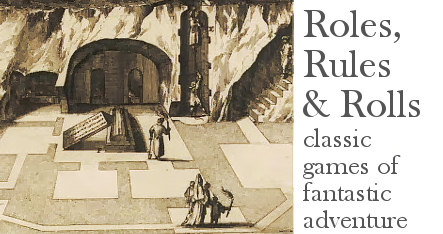A couple of examples:
- The party is headed out to the castle to fight some bandits. By crazy coincidence is their friend the ranger just coming back from his conclave in the woods and does he run into them and offer to join their righteous expedition? (He did, and this saved the party's bacon.)
- Last week, the party was heading out of town on a caravan. I roll up some random characters along for the ride. One of them is a "Guard" and the other is an "Elf"? Is the elf the very same high-elf who had been pitching woo to one of the party members? (No.) Is the guard the very same fellow who went into the dungeon with the party, blackmailed them for a take of the treasure on account of their using illegal poison arrows, thought they were quits because he didn't testify against them in their trial, and is leaving town because his corrupt ways have come to light? (Yes - and in yesterday's session, a carousing episode in a far-away town gave him his comeuppance in a completely randomly determined yet amazingly elegant way.)
All this comes from my reading of an article by the literary scholar Hilary Dannenberg called A Poetics of Coincidence in Narrative Fiction (Poetics Today 25:3, Fall 2004, if you have university library access). Let's leave aside the theme of separated family members meeting by coincidence - which underpins a surprising number of classics from Oedipus Rex, to The Tempest, to Fielding's Tom Jones. A more general use of coincidence, corresponding to my use of dice, is to have characters meet again when the reader thinks they have separated from each other.
In general, Dannenberg says that such coincidences in literature demand an explanation by the author, who often complies. Sometimes coincidence is explained explicitly as a sign of the hand of Providence within the story. Other times it's done with a nod and a wink to literary contrivance; certainly it is more satisfying to pick up an old character where they left off and develop them further, than to start anew. But at still other times, particularly in realist novels, it's just explained as one of those chance meetings or an incredible happenstance. In effect, this last one is the explanation I give my players when I announce the chance for a coincidence and roll the die in plain view.
Now, if I was being a total realist about things, the coincidence die would only hit on a 1 in 100 chance or lower. Indeed, sometimes when something would be just too bizarre a coincidence, I roll 2 dice and require 2 sixes (in today's session, there were human heads on stakes by the side of the road - does anyone recognize them?) Yet even this 1 in 36 chance, or the 1 in 6 normal chance, is weighted heavily to let coincidences happen. And in this I recognize I'm telling a literary story, that sometimes could get some good mileage out of recycling and developing a character, but works best if it's seen as not completely stage-managed.



































